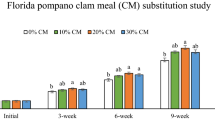Abstract
Unheated and heated (121 °C, 66% moisture; 15, 30 and 45 min) Jatropha meals of non-toxic provenance from Veracruz state in Mexico were evaluated using rats and fish. With rats, the weight gain was highest for the casein diet followed by heated (30 min; only this treatment was studied using rats) and unheated Jatropha meal containing diets. The protein efficiency ratio (PER) for unheated and heated Jatropha meal containing diets was 37 and 86%, respectively, of the casein diet. On the other hand, the body weight gain, PER and feed conversion ratio of fish were statistically similar for unheated and heated (15, 30 and 45 min) Jatropha meal containing diets fed for a period of 35 days. Although these parameters were statistically similar for the unheated and heated Jatropha meal containing diets, the body weight gain, PER and protein productive value were highest and the feed conversion ratio lowest with 15 min heated Jatropha meal, suggesting that the heat treatment for 15 min is optimal for the meal. Trypsin inhibitor and lectin activities decreased drastically (>83 and 99%, respectively) after 30 and 45 min of heat treatment and after 15 min, the residual lectin activity was negligible and the residual trypsin inhibitor activity was 34%. These results, together with the nutritional parameters investigated, imply that Jatropha trypsin inhibitors and lectins do not have any adverse effects on carp at least up to 35 days of feeding. The nutritional value of Jatropha meal of the non-toxic provenance is high, and potential exists for its incorporation into the diets of monogastrics, fish and possibly humans.
Similar content being viewed by others
References
Heller J (1996) Physic nut Jatropha curcasL. Promoting the conservation and use of underutilized and neglected crops. 1. Institute of Plant Genetics and Crop Plant Research, Gartersleben, International Plant Genetic Resources Institute, Rome.
Makkar HPS, Becker K (1997) Potential of Jatropha seed cake as protein supplement in livestock feed and constraints to its utilization. In: Gübitz GM, Mittelbach, M, Trabi M (eds), Biofuels and Industrial Products from Jatropha curcas. Austria: Dbv-Verlag für die Technische Universität Graz, pp. 190–206.
Makkar HPS, Becker K (1998) Jatropha curcas toxicity: identification of toxic principle(s). In: Garland T, Barr AC (eds), Toxic Plants and Other Natural Toxicants. CAB International, U.K., pp. 554–558.
Makkar HPS, Aderibigbe AO, Becker K (1998) Comparative evaluation of non-toxic and toxic varieties of Jatropha curcas for chemical composition, digestibility, protein degradability and toxic factors. Food Chemistry 62: 207–215.
Makkar HPS, Becker K, Schmook B (1998) Edible provenances of Jatropha curcas from Quintana Roo state of Mexico and effect of roasting on antinutrient and toxic factors in seeds. Plant Foods Hum Nutr 52: 31–36.
Eggum BO, Beames RM, Wolstrup J, Knudsen KEB (1984) The effect of protein quality and fibre level in the diet and microbial activity in the digestive tract on protein utilization and energy digestibility in rats. Brit J Nutr 51: 305–314.
Association of Official Analytical Chemists (1980) Official Methods of Analysis, 13th ed. Washington, DC: Association of Official Analytical Chemists.
Aregheore EM, Makkar HPS, Becker K (1998) Assessment of lectin activity in a toxic and a non-toxic variety of Jatropha curcas using latex agglutination and haemagglutination methods and inactivation of lectin by heat treatments. J Sci Food Agric 77: 349–352.
Smith C, Van Megen W, Twaalhoven L, Hitchcock C (1980) The determination of trypsin inhibitor levels in foodstuffs. J Sci Food Agric 3: 341–350.
Aderibigbe AO, Johnson COLE, Makkar HPS, Becker K, Foidl N (1997) Chemical composition and effect of heat on organic matter and nitrogen-degradability and some antinutritional components of Jatropha meal. Anim Feed Sci Technol 67: 223–243.
Liener IE (1989) Antinutritional factors in legume seeds: state of the art. In: Huisman J, van der Poel and Liener IE (eds), Recent Advances of Research in Antinutritional Factors in Legume Seeds. Pudoc, Wageningen, pp. 6–14.
Escaffre AM, Infante JLZ, Cahu CL, Mambrini M, Bergot P, Kaushik SJ (1997) Nutritional value of soy protein concentrate for larvae of common carp (Cyprinus carpio) based on growth performance and digestive enzyme activities. Aquaculture 153: 63–80.
Wilson RP, Poe WE (1985) Effects of feeding soybean meal with varying trypsin inhibitor activities on growth of fingerling channel catfish. Aquaculture 46: 19–25.
Dabrowski K, Poczyczynski P, Köck G, Berger B (1989) Effect of partially or totally replacing fish meal protein by soybean meal protein on growth, food utilization and proteolytic enzyme activities in rainbow trout (Salmo gairdneri). New in vivo test for exocrine pancreatic secretion. Aquaculture 77: 29–49.
Shimeno S, Hosokawa H, Yamane R, Masumoto T, Ueno SI (1992) Change in nutritive value of defatted soyabean meal with duration of heating time for young yellowtail. Nippon Suisan Gakkaishi; Bulletin of the Japanese Society of Scientific Fisheries 58: 1351–1359.
Shu SW (1992) Effect of trypsin inhibitor on the growth of Nile tilapia. Acta Hydrobiologia Sinica 16: 18–23.
Olli JJ, Hjelmeland K, Krogdahl A (1994) Soyabean trypsin inhibitors in diets for Atlantic salmon (Salmo salarL): effects on nutrient digestibilities and trypsin in pyloric caeca homogenate and intestinal content. Comp Biochem Physiol 109A: 923–928.
Abel HJ, Becker K, Meske C, Friedrich W (1984) Possibilities of using heat-treated full-fat soybeans in carp feeding. Aquaculture 42: 97–108.
Viola S, Mokady S, Ariel Y (1983) Effects of soybean processing methods on the growth of carp (Cyprinus carpio). Aquaculture 32: 27–38.
Author information
Authors and Affiliations
Rights and permissions
About this article
Cite this article
Makkar, H., Becker, K. Nutritional studies on rats and fish (carp Cyprinus carpio) fed diets containing unheated and heated Jatropha curcas meal of a non-toxic provenance. Plant Foods Hum Nutr 53, 183–192 (1999). https://doi.org/10.1023/A:1008087627894
Issue Date:
DOI: https://doi.org/10.1023/A:1008087627894




